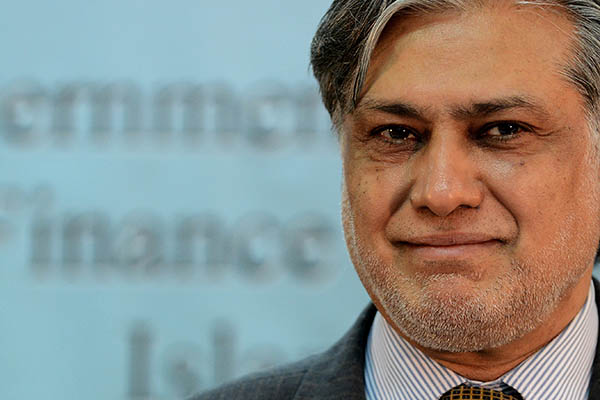
File photo. Farooq Naeem—AFP
Muhammad Ishaq Dar, Pakistan’s latest (and returning) finance minister—the 42nd in the country’s 75-year history facing an economy in a nosedive—is back in Pakistan after five years in self-exile. Politically, the opinion against him is not worthy of trust; yet it is unavoidable to look back. In 2012, Pakistan’s economy was in trouble with an inflation rate of 9.7 percent; in 2015, after two years under him, it had come down to 2.5 percent. His record has appeared in the press: “In 2012, a year before Ishaq Dar took over as finance minister, the lending rate of interest in Pakistan was 13.5 percent. In 2013, the year that Ishaq Dar took over as finance minister, the lending rate of interest had dropped to 12 percent. By 2017, four years after Ishaq Dar took over, the lending rate of interest had dropped to a low of 8.2 percent.”
The circumstances in which he has taken over are in concentrated bipolarity with the political negativity of Imran Khan, who will look down on everything Dar does as intrigue. Yet, look at this: “Ishaq Dar took oath of office on the 7th of June, 2013. The average exchange rate in 2013 was Rs. 101 to-a-dollar. Ishaq Dar’s last day in office was the 22nd of November, 2017. The average exchange rate in 2017 was Rs. 105 to-a-dollar.” Dar maintains this reflected natural growth; many economists claim otherwise, alleging he utilized expensive loans to shore up the exchange rate at the expense of macroeconomic indicators. They also claim he will use similar policies in this tenure to “artificially” improve the rupee’s standing.
But Dar is handicapped in a way he was not last time: the incumbent government might be wrapped up within this year, or linger into 2023 with everything hanging by a hair, which doesn’t give him much time to deliver success. In either scenario, Dar has less than a year in office with the PMLN leadership visibly divided on many governance issues. If you look at the scene from P.M. Shehbaz Sharif’s point of view, then Dar might appear a rival, with Maryam Nawaz spoiling the pitch for her uncle. The rift could also widen further if Nawaz Sharif returns to Pakistan, as has been suggested in recent weeks. Dar’s tenure, thus, could face significant difficulties due to the Sharif clan’s internal differences, especially as the PMLN struggles to regain ground lost to Imran Khan.
Adding to Dar’s woes is the nature of the economic crisis facing Pakistan, as a global recession looms with weak currencies in flight and pursuit of the dollar getting countries in trouble. Can he live with an over-valued rupee? Or can he survive with the way the rupee has been losing value in the market where a roti selling in the past for Rs. 10 rupees is now fetching Rs. 20? Clearly, he would prefer a stronger rupee, as he recently vowed to bring the dollar down to roughly Rs. 200, stressing this would curtail inflation and boost economic growth. Meanwhile, the neutral observer—if that is possible in a politically polarized country—is upset by the hand that has been dealt to “outgoing” finance minister Miftah Ismail. One verdict that appeared in the press went like this: “Ismail had been dealt a poor hand when he took office six months ago with the economy and the rupee in free fall and did what he could to stabilize the economy and the exchange rate. His major feat is to stave off the Sri Lanka type debt default that was imminent a few weeks back. This he achieved despite constant sniping from Dar ensconced in London on ‘medical grounds’ and Shaukat Tarin, the former finance minister in the PTI government, stewing on the sidelines and trying to set roadblocks to the IMF agreement.”
